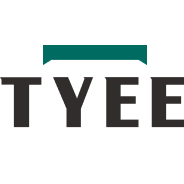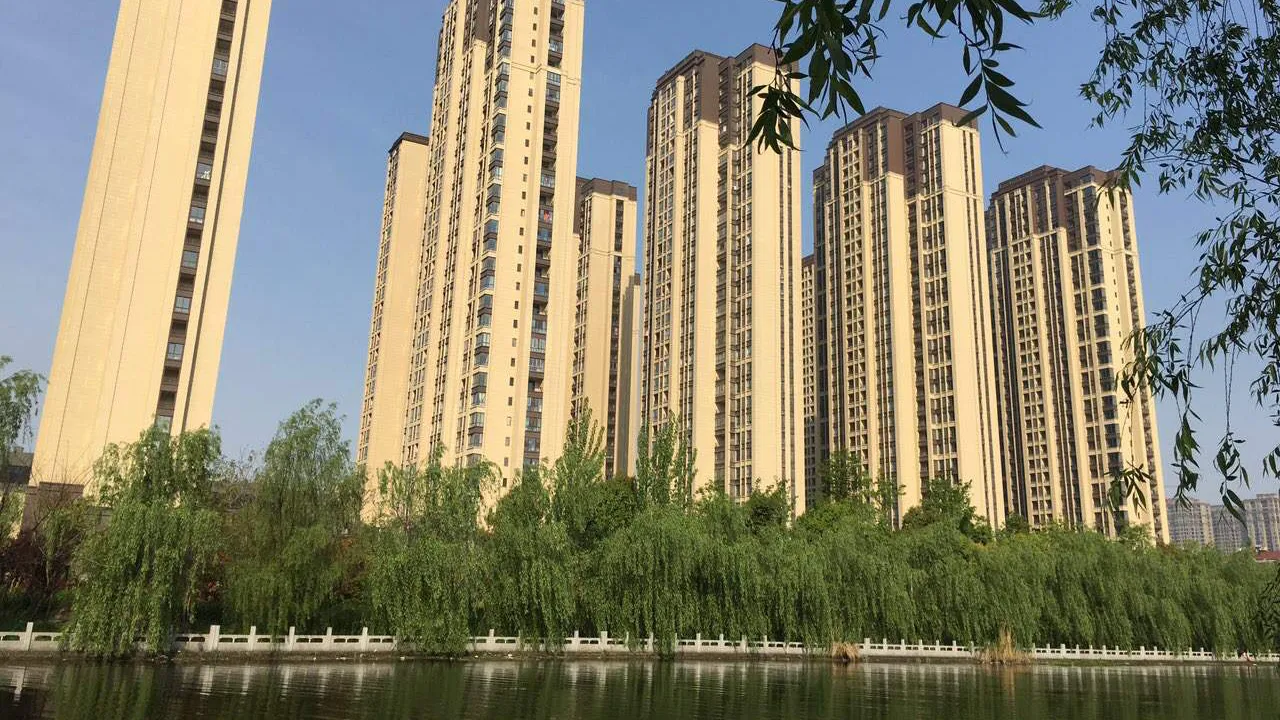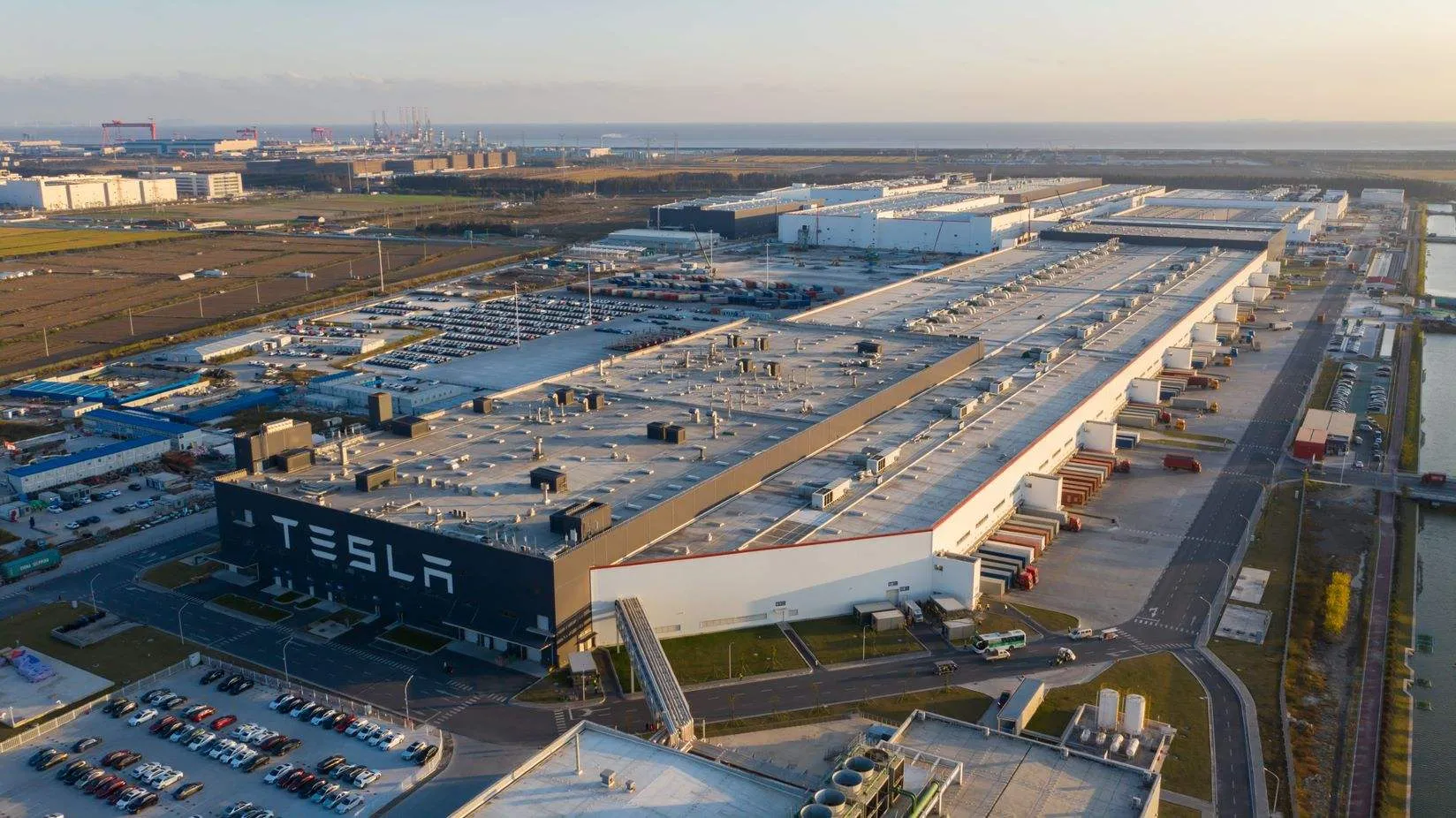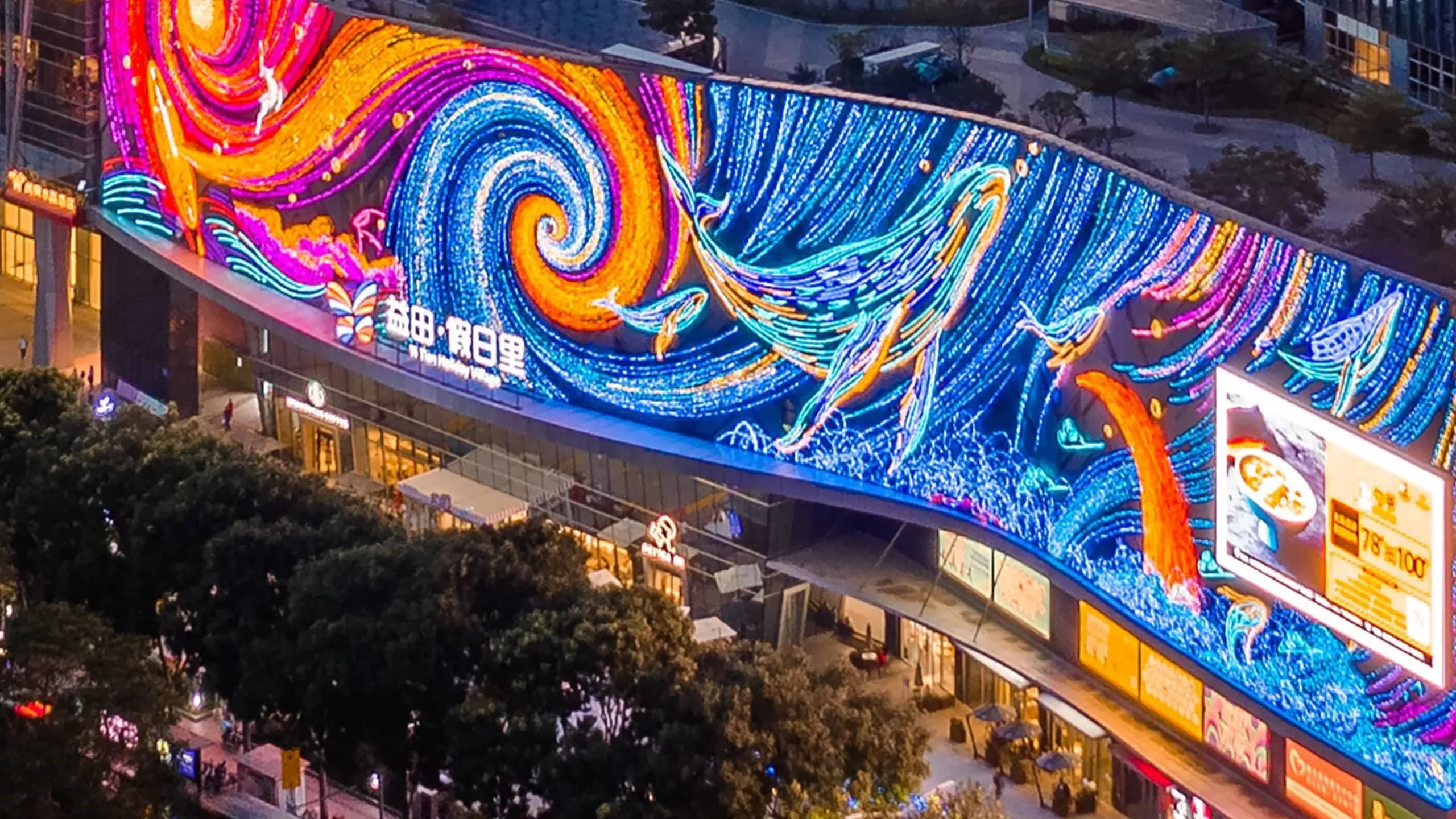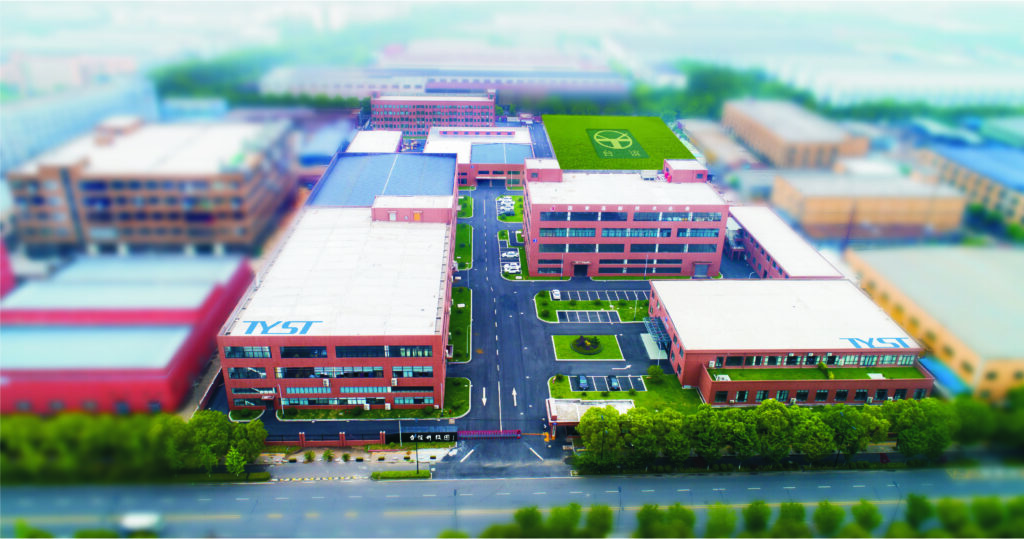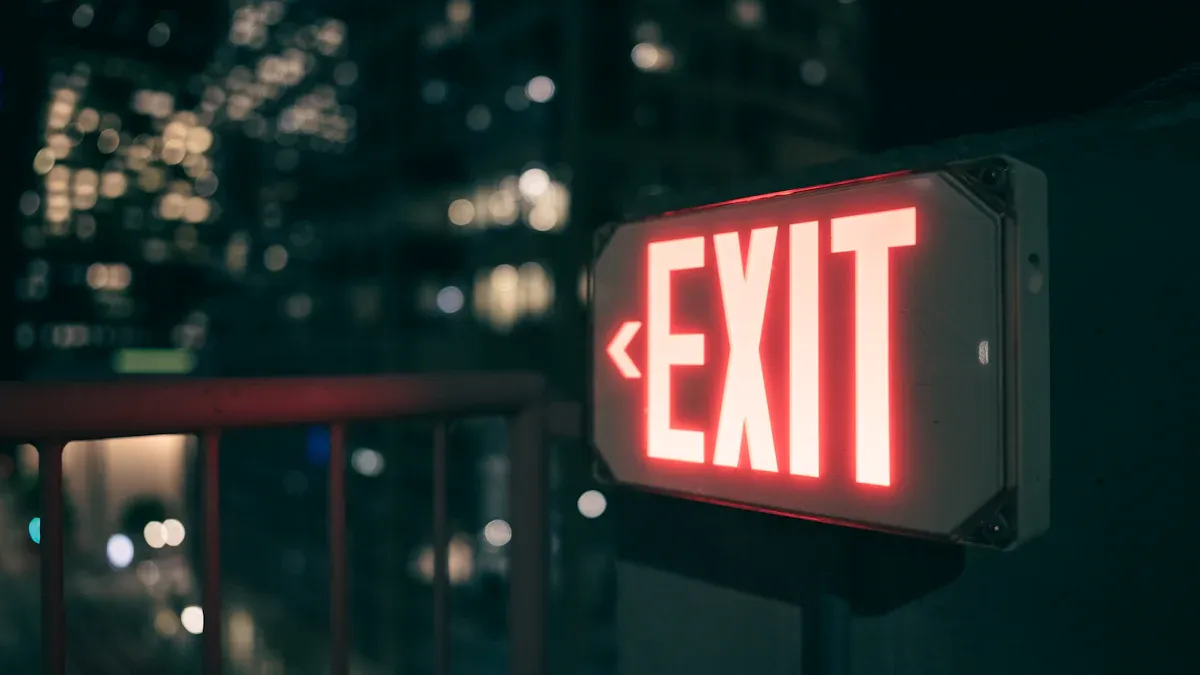
You live in a city where every alley feels crowded. Every building seems full. Ho Chi Minh City has over 4,400 people in each square kilometer. Almost 39 million people live in Vietnam’s cities now. Crowded neighborhoods and narrow streets are everywhere:
Ho Chi Minh City, Hanoi, Hai Phong, Da Nang, Bien Hoa, and Can Tho have the most people in small areas.
Some places have almost 15 times more people than the country’s average.
When emergencies happen, you need a plan that works. Safe Evacuation Strategies help guide everyone to safety. Advanced solutions like TYEE’s Emergency Lighting and Evacuation Indication Systems help too. They work even in very tight spaces.
Key Takeaways
Find your nearest exit and learn your way out. Knowing your route can help you in emergencies.
Look for emergency lights and clear signs to guide you. These tools show safe paths in smoke or darkness.
Listen for updates during an evacuation. Alerts help you stay away from crowds and blocked exits.
Join community drills and training. Working with neighbors makes everyone safer and ready.
Find safe places in your building. Knowing where to wait for help keeps you safe if you cannot leave right away.
Urban Risks and Challenges in Vietnam
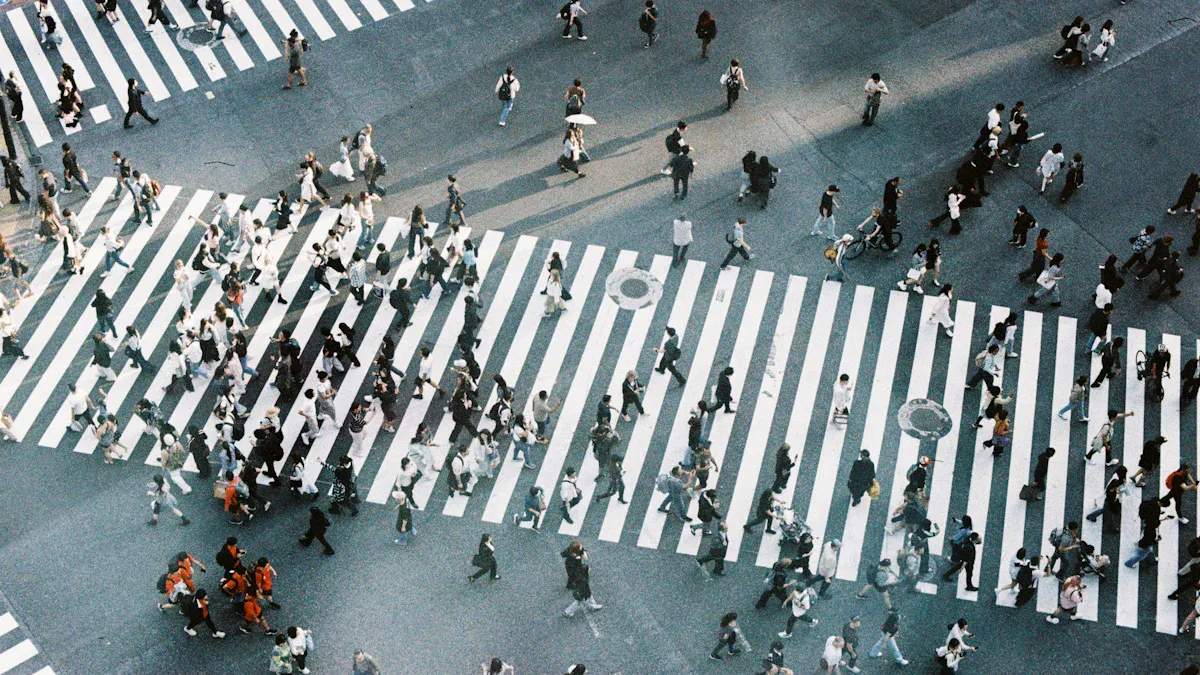
High-Risk Areas
There are many risks in Vietnam’s busy city centers. Old neighborhoods and small alleys make it hard to leave quickly. Crowded places slow down evacuation. Some provinces like Thanh Hoa, Quang Tri, Hue, and Danang have many homes in danger zones. Over 152,000 homes are in these risky areas. Almost 600,000 people had to leave their homes during emergencies like Typhoon Kajiki. Crowds can block exits and stop rescue teams from moving fast. Narrow alleys make it hard for emergency vehicles to get through. This causes traffic jams and slows down help when time is important.
Traffic jams are worse during busy times.
Pickpocketing happens a lot in crowded spots.
Common Hazards
Vietnam has a lot of people and special dangers. Floods, tropical cyclones, and droughts happen every year. The table below lists the most common hazards in busy city centers:
Hazard Type | Description |
|---|---|
Flooding | |
Tropical Cyclones | Cities often face cyclones and their dangers. |
Drought | Bad droughts, like in 2015–2017, hurt many people. |
Heavy rain and low land make floods worse. Bad city planning and crowded streets cause exit problems. These problems make it harder to leave safely in an emergency.
Crowd Behavior
Crowds act in different ways during emergencies. Some people wait because they worry about their things. Others think they can handle it alone. Some wait for help and do not leave soon enough. During floods, knowing the danger helps people leave faster. Teaching people and having safe places to go helps everyone make better choices. In busy city centers, crowds can move in a messy way. Clear signs and good instructions help keep people safe.
Tip: If you live in a crowded place, always know your closest exit and listen for emergency alerts. Moving fast can save lives.
Safe Evacuation Strategies
If you live in a city, emergencies can happen fast. Safe evacuation strategies help you leave quickly and safely. You need to know your routes, exits, and safe waiting spots. Let’s see how you can use good evacuation strategies in crowded cities in Vietnam.
Evacuation Route Planning
Planning helps everyone get out fast. Good strategies start with finding the safest paths. You should know which streets and alleys are open. Check for blocked roads and crowded places. Planners use models to look at flood risks and busy areas. These models help you find the best way out.
Here’s a table that shows how experts use planning to make evacuation better:
Key Component | Description |
|---|---|
Study Focus | Urban flood risk assessment and evacuation planning in high-density areas. |
Methodology | Bi-level optimization model with flood risk, population, and road data. |
Evacuation Simulation | |
Findings | Finds high-risk areas and improves emergency planning. |
Application | Helps government make better evacuation strategies. |
TYEE’s Emergency Lighting and Evacuation Indication System makes planning easier. The system uses real-time fire alarm data to guide you. If a fire blocks one exit, the signs change and show a new way. You see bright lights and arrows, even in smoke or darkness. You do not have to guess where to go. The system helps you follow safe evacuation strategies every step.
Tip: Walk around your building and learn every exit. Practice your route so you can move fast when needed.
Exit and Shelter Design
You need exits that are easy to see and wide enough. Good planning means you have more than one way out. You should see exit signs from anywhere in the room. Shelters must be close and easy to reach. How exits and shelters are built affects how fast you can leave.
Check out this table to see what matters most:
Evidence | Description |
|---|---|
Exit Door Visibility | You leave faster when you see exit doors clearly. |
Minimum Stair Width | Stairs should be at least 1.05–1.28 meters wide to stop crowding. |
Number of Exits | More exits mean safer and faster evacuation strategies. |
TYEE’s system uses bright LED signs and emergency lights. You spot exits right away, even if the power goes out. The system meets national safety codes for exit width and sign placement. You get clear guidance to shelters and safe zones. You do not waste time looking for a way out. The system helps you find exits and shelters fast.
Note: If you see blocked exits or messy stairs, tell someone. Clear paths save lives.
Refuge Spaces in Dense Areas
Sometimes you cannot leave the building right away. You need a safe place to wait for help. Refuge spaces keep you safe until rescue teams come. Good planning means you know where these spaces are and how to get there.
Here’s what helps make refuge spaces work:
Good planning and management of emergency spaces help people leave faster.
High population and small open areas cause crowding. You need extra channels to help people move.
Organizing refuge spaces well lowers risks and helps evacuation strategies work.
TYEE’s system helps you find refuge spaces fast. The lights and signs show you the nearest safe zone. The system can change directions if a fire blocks your path. You get real-time updates and clear instructions. You feel safer because you know where to go and what to do.
Callout: Always check for refuge spaces in your building. Ask your manager where they are and how to get there.
Safe evacuation strategies work best when you use smart planning, clear exits, and good refuge spaces. TYEE’s Emergency Lighting and Evacuation Indication System gives you guidance, helping you follow evacuation strategies that keep you safe in any emergency.
Designing Evacuation Plans
Making good evacuation plans is more than drawing arrows. You must think about how people move and where they gather. Technology can help make plans better. Let’s look at how to design evacuation plans for crowded cities in Vietnam.
Optimizing Routes for High-Density Areas
You want everyone to leave fast and safe. First, learn all exits and escape routes in your building or area. Think about stairwells, fire-resistant doors, and windows if needed. Use phased evacuation or defend-in-place if the building is complex.
Today, smart technology can improve your evacuation plans. TYEE’s solutions use real-time data and adaptive guidance. The system changes exit signs and lights when danger moves. Machine learning helps find crowded spots and the best way out. Here are some models that help:
Model | What It Does |
|---|---|
EXIT89 | Finds the fastest escape routes and reroutes around obstacles in real time. |
BEETOM | Optimizes when and how people leave, cutting total evacuation time by up to 20%. |
These models help you avoid crowds and reduce delays.
Tip: Walk your route. Do not just remember it—practice it!
Strategic Placement of Shelters and Assembly Points
You need safe places to meet during emergencies. Good evacuation plans always include easy-to-reach shelters. Shelters should be close—no more than 500 meters or a 15-minute walk. They connect to main roads and have enough space for everyone.
Criteria | What It Means |
|---|---|
Accessibility | You can reach the shelter quickly, even if you have a disability. |
Safety | The spot is away from hazards and not on a fault line. |
Size | There’s at least 1.5 square meters per person. |
Usability | The area has water, electricity, and is flat with no big obstacles. |
TYEE’s system uses signs and updates to guide you to these points.
Area-Based Evacuation Plans
Each neighborhood is different. Evacuation plans should fit the local area. Centralized control systems, like TYEE’s, give you a big-picture view. You see where people are, which exits are open, and where dangers might be. The system can change directions as things happen, making plans flexible.
Machine learning and AI check traffic, weather, and social media for problems. You get alerts if a route is blocked or a shelter is full. This makes your evacuation plans smarter and safer.
Remember: The best plans use smart design and technology. Stay alert and follow the signs.
Evacuation Systems and Technology
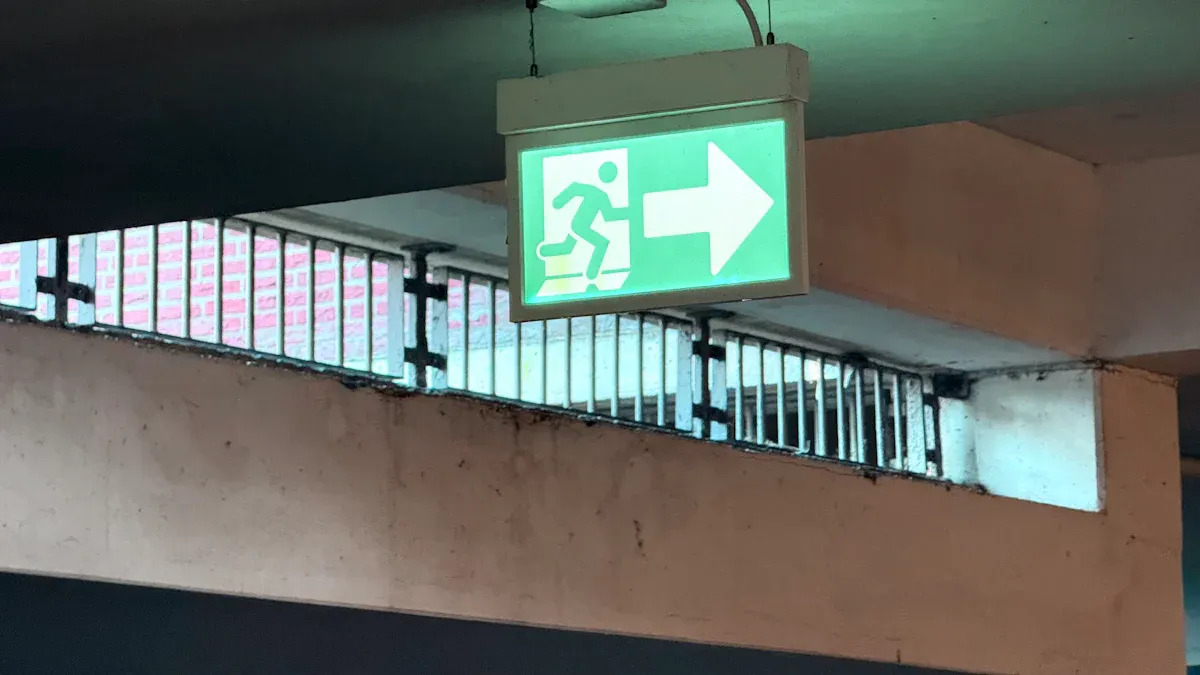
Emergency Lighting & Evacuation Indication Systems
Getting out fast and safe is important in an emergency. Emergency lighting and evacuation indication systems help you find the way out. TYEE’s system uses bright LED signs and smart lights. These lights show you where to go, even if there is smoke or no power. Arrows and signs change as things happen. They guide you away from danger. Research says clear signs help people escape faster and feel less scared. Emergency lighting makes it easy to see exit doors. This helps you stay calm when things are confusing.
Here’s how new technology helps people evacuate in Vietnam:
Technological Advancement | Description |
|---|---|
Intelligent escape solutions | Systems that help you leave quickly and safely during emergencies. |
Automated escape chutes | Devices that let you descend fast in tall buildings. |
Fire-retardant evacuation pods | Pods that protect you from fire while you wait for help. |
IoT-enabled alert mechanisms | Real-time alerts and updates keep you informed during evacuation. |
When you follow the lights and signs, you help everyone get out faster.
Tip: Always look for emergency lights and signs in your building. They can save your life.
Fire Alarm Systems
You need to know about danger right away. TYEE’s Non-addressable Fire Alarm System gives fast alerts. Loud bells, flashing lights, and easy call points warn you. Smoke and heat sensors find problems early. This lets you start leaving before things get worse. These systems work well in busy cities. They are easy to put in and use. You do not need special training to use them.
Benefit | Description |
|---|---|
Simplicity | Easy to install and maintain. |
Cost-effectiveness | Saves you money on equipment. |
Quick detection | Sensors and alarms warn you fast. |
Ease of use | Anyone can use it. |
Suitable for urban environments | Perfect for busy city buildings. |
You get quick warnings, so you can start leaving right away.
Real-Time Monitoring & Intelligent Evacuation
You want to know what is happening as you leave. TYEE’s systems watch where people are and how they move. Automated counting and live maps help managers see crowded spots. Heatmaps show where crowds are building up. This helps you avoid busy areas. Instant alerts tell you if a hallway is too full or a path is blocked.
Automated counting lets managers know how many people are inside.
Live maps and heatmaps show less crowded exits.
Instant alerts keep evacuation smooth and organized.
Studies show that smart monitoring helps people leave faster. It also helps rescue teams know where to go.
Note: If you see an alert or hear an alarm, follow the signs and move calmly to safety.
Crowd Management and Communication
Handling a crowd in an emergency can be hard. You need clear rules and good ways to talk to people. Good planning starts before anything bad happens. Let’s see how you can use the best crowd management and communication ideas in Vietnam’s busy cities.
Information Dissemination
You need news fast when things go wrong. Real-time alerts tell you what to do and where to go. TYEE’s systems send quick updates to your phone or speakers. You see arrows and lights that change as things happen. This kind of help keeps you moving the right way.
Here’s a table with some top crowd management and communication ideas:
Strategy | Description |
|---|---|
Routes help everyone, even people who need extra help, for fair and quick evacuation. | |
Use of Technology | Phones and sensors give you real-time help through easy apps. |
Inclusivity | Plans help all people, giving more time and help to those who need it most. |
You get help that fits your needs, no matter who you are.
Training and Awareness
You should not wait for an emergency to learn what to do. Training helps a lot. In Vietnam, training programs teach many students in flood-prone places. Kids share what they learn with their families, so everyone gets better at staying safe. These programs help people act better and lower harm.
Students learn what to do in emergencies.
Families and neighbors hear about these skills.
The whole community gets safer and more ready.
TYEE supports training for everyone and for emergency workers. You get the knowledge and help you need to act fast.
Community Engagement
You are important in crowd management. When you join drills or meetings, you help your area get ready. Local leaders and organizers work with residents to build trust and share helpful information. You can ask questions, give ideas, and help plan better escape routes. This teamwork makes leaving safer for everyone.
Tip: Join your next community safety drill. You will learn new tips and help others stay safe.
Behavioral Guidance in High-Density Scenarios
Crowds can panic if they do not have clear help. You need simple steps and signs you can see. TYEE’s systems use lights, sounds, and real-time updates to guide you. Managers watch live maps and send alerts if a path is crowded. You follow the help, stay away from danger, and help others too.
Good management means you always know what to do. You see help everywhere—on signs, your phone, and from leaders. This keeps the evacuation calm and organized.
Implementation, Drills, and Simulation
Conducting Drills and Testing
You can’t just make plans and hope they work. You need to practice. Regular drills help everyone know what to do when an emergency happens. TYEE supports you with system installation, training, and ongoing maintenance, so your drills run smoothly every time. When you practice, you learn the fastest way out and spot any problems with your routes.
Here are some best ways to run drills in crowded places:
Set up multiple exits to stop crowds from getting stuck.
Hold drills often so everyone remembers the routes.
Use clear signs and emergency lights to guide people.
Try out evacuation simulation tools to find slow spots.
Invite everyone to safety workshops to learn the right evacuation actions.
When you practice together, you build confidence and make your plans stronger.
Monitoring Evacuation Efficiency
After each drill, you should check how well your plans worked. TYEE’s systems help you track how fast people move and where they get stuck. You can use live maps and counting tools to see if exits are clear and if everyone gets out safely. If you find a problem, you can fix your plans right away. This keeps your community ready for anything.
Tip: Always review your drills. Ask, “Did everyone follow the plan? Did anyone have trouble?” Small changes can make a big difference.
Learning from Past Incidents
You can learn a lot from what happened before. In Vietnam, more families started making evacuation plans after big floods. People now think about the safety of children and older adults first. Some families even keep boats ready, just in case. Still, not everyone has plans, so there’s room to grow.
Here’s what past events have taught us:
More people now make plans before storms or floods.
Families help the most vulnerable leave first.
Boats and other tools help people escape when roads flood.
Some still don’t have plans, so keep working to include everyone.
Looking back at past events helps improve your own plans. Regularly check routes, exits, and refuge spaces, and practice drills whenever possible. Each time you do, evacuation becomes safer and more effective.
FAQ
What should you do if you get lost during a pedestrian evacuation in a large stadium?
Try to stay calm. Look for emergency signs or find a staff member. Follow the crowd, but do not push anyone. If you see a safe exit, go to it. Large stadiums have special paths for pedestrian evacuation. Ask someone for help if you need it.
How do emergency systems help with pedestrian evacuation in large-scale public buildings?
Emergency systems help you find the way out. Lights and signs show each pedestrian where to go. In big public buildings, these systems help you skip crowded areas and move fast. You can trust the signs during a pedestrian evacuation.
Why is it important to keep exits clear for pedestrian evacuation?
Blocked exits make everyone slower. If you see something blocking the way, tell someone right away. Clear exits help each pedestrian leave quickly. During a pedestrian evacuation, you want nothing in your way.
Can you use the same pedestrian evacuation plan for large stadiums and small buildings?
No, you need different plans for each place. Large stadiums have more people and bigger spaces than small buildings. Pedestrian evacuation is faster in small buildings. In large stadiums, follow the signs and listen to staff. Every place has its own plan for each pedestrian.
What should you do if you see another pedestrian struggling during an evacuation?
Help if you can do it safely. Tell a staff member or emergency worker. In a pedestrian evacuation, everyone should help each other. Stay together and move calmly. You help keep every pedestrian safe.

